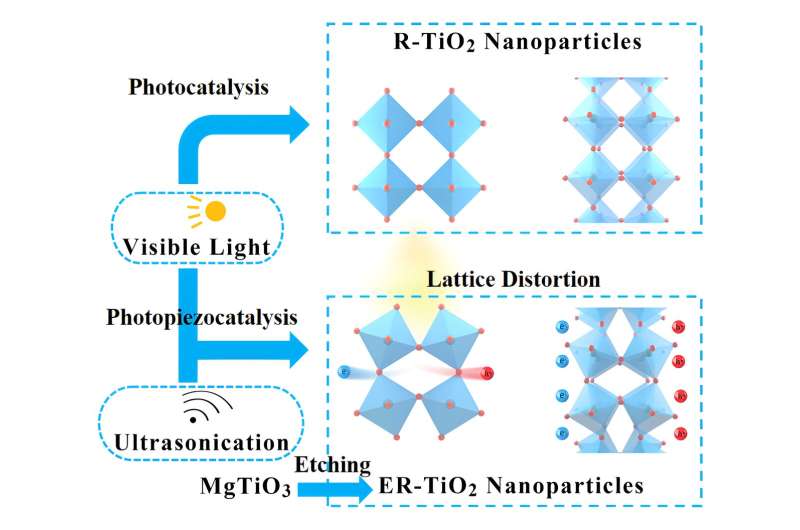This article has been reviewed according to Science X's editorial process and policies. Editors have highlighted the following attributes while ensuring the content's credibility:
fact-checked
proofread
Team induces piezoelectricity for enhanced tetracycline hydrochloride degradation through photopiezocatalysis

A team of material scientists recently outlined the state of inducing piezoelectricity in distorted rutile TiO2 for enhanced tetracycline hydrochloride degradation through photopiezocatalysis. The team was led by Prof. Qi Li from Southwest Jiaotong University in Chengdu, China.
Various material design strategies have been developed to enhance the photocatalytic performance of TiO2. However, no report is available on applications of the photopiezocatalysis strategy on TiO2 due to its lack of piezoelectricity.
Here, they developed a low-temperature molten salt etching process to create rutile TiO2 nanoparticles by etching [MgO6] octahedrons away from MgTiO3 by molten NH4Cl, during which a lattice distortion occurred in TiO2. Lattice distortion leads to a piezoelectric response in the sample, which is then applied in the field of photocatalysis, improving the degradation performance of antibiotics.
The team published their paper in the Journal of Advanced Ceramics.
In this paper, a low-temperature molten salt etching process was developed with MgTiO3 as a raw material and NH4Cl as molten salt. By etching [MgO6] octahedrons away from MgTiO3 in this specific synthesis process, rutile TiO2 nanoparticles (the ER-TiO2 sample) were created with distorted crystal lattice as demonstrated by the XRD Rietveld refinement analysis.
By breaking the structure symmetry of rutile TiO2 through the lattice distortion, the ER-TiO2 sample was endowed with an unusual and interesting piezoelectric response for the first time as revealed by the piezoelectric response force microscopy (PFM) analysis.
As one important kind of emerging contaminant, the contamination from pharmaceutical and personal care products (PPCPs) is raising increasing concerns. Tetracycline hydrochloride (TC–HCl) is a commonly used broad-spectrum antibiotic, and its release into water and soil causes serious environmental pollution problems and poses threats to human beings.
Through the introduction of piezoelectricity, it was found that the ER-TiO2 sample had an improved photocatalytic degradation effect on tetracycline hydrochloride (TC–HCl) under visible light illumination than its commercially available rutile TiO2 nanoparticle counterpart.
More significantly, its TC–HCl degradation efficiency was largely enhanced by 71% than its photocatalytic degradation performance when the synergistic photopiezocatalytic effect was present.
"The photopiezocatalysis approach could be a novel strategy for the photocatalytic performance enhancement of TiO2 from the introduction of piezoelectricity into it through the creation of lattice distortion," said Prof. Li.
Other contributors include Jinghui Wang from Shenyang National Laboratory for Materials Science, Institute of Metal Research, Chinese Academy of Sciences, Shenyang, China.
More information: Taotao Xia et al, Inducing piezoelectricity in distorted rutile TiO2 for enhanced tetracycline hydrochloride degradation through photopiezocatalysis, Journal of Advanced Ceramics (2024). DOI: 10.26599/JAC.2024.9220855
Provided by Tsinghua University Press





















